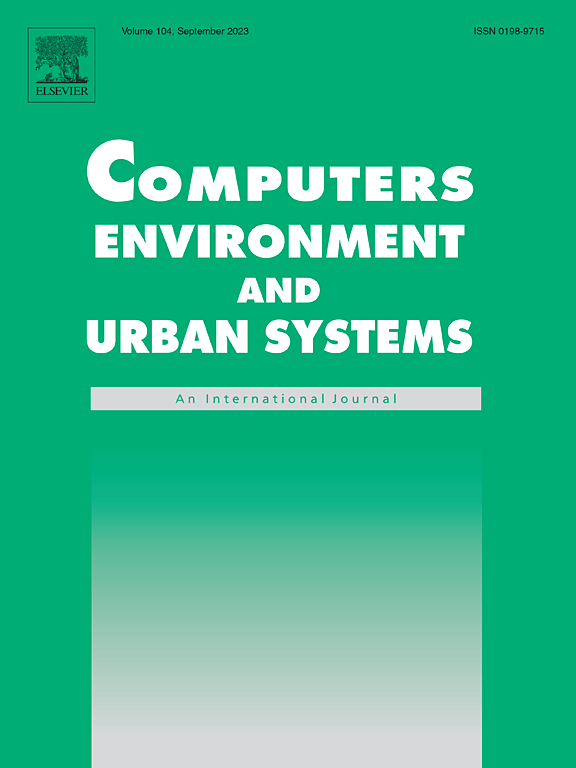Prediction of particulate matter (PM) in rural built environments based on Generative Adversarial Network (GAN)
IF 8.3
1区 地球科学
Q1 ENVIRONMENTAL STUDIES
Computers Environment and Urban Systems
Pub Date : 2025-10-09
DOI:10.1016/j.compenvurbsys.2025.102357
引用次数: 0
Abstract
Particulate matter (PM) is a key parameter for characterizing outdoor air quality. PM concentration is closely related to features of built environment. Rural built environment elements at block scale, such as building massing, impermeable surfaces, and farmlands, significantly impact the PM concentration. However, current research has focused on large-scale and broad-spectrum forecasting models, which are difficult for guide designers to apply because they lack rapid, detailed forecasting and specific visualization. This study proposes an automated design procedure using the Generative Adversarial Network (GAN) model to perform spatial planning oriented by environmental performance in rural blocks. This study collected and obtained data, including satellite land cover maps and PM concentrations, to construct a prediction model. Then, the model was used to quickly and accurately predict the concentrations of three kinds of particulate matter, PM1, PM2.5, and PM10 under different design scenarios. This study found that first, the ratio between industrial and residential buildings (IB:RB) was positively correlated with PM concentration. The buildings with a short-strip configuration exhibited the lowest PM concentration in their environment compared to clusters of buildings in long strips or block-form structures. Second, the ratio between roads and small squares (R:SS) showed a positive correlation with PM concentration. The impervious surfaces characterized by large block configurations demonstrated the lowest PM concentration among the five planar forms evaluated. Third, farmland coverage exhibited a weak negative correlation with PM concentration. Farmlands with small blocks had the lowest PM10 levels among five different planar forms, and small dotted farmlands had the lowest PM1 and PM2.5 levels. Finally, the model was used to simulate PM concentration under different design scenarios and suggested interactive strategies for future rural spatial planning design.
基于生成对抗网络的农村建筑环境颗粒物(PM)预测
颗粒物(PM)是表征室外空气质量的关键参数。PM浓度与建筑环境的特征密切相关。街区尺度的农村建筑环境要素,如建筑体量、不透水表面和农田,对PM浓度有显著影响。然而,目前的研究主要集中在大规模、广谱的预测模型上,这些模型缺乏快速、详细的预测和具体的可视化,给导盲设计人员的应用带来了困难。本研究提出了一个使用生成对抗网络(GAN)模型的自动化设计程序,以农村街区的环境绩效为导向进行空间规划。本研究收集并获得了包括卫星土地覆盖图和PM浓度在内的数据,以构建预测模型。然后,利用该模型快速准确地预测了不同设计场景下PM1、PM2.5和PM10三种颗粒物的浓度。本研究发现,首先,工业建筑与住宅建筑之比(IB:RB)与PM浓度呈正相关。与长条形或块状结构的建筑群相比,短条形结构的建筑在其环境中表现出最低的PM浓度。②道路与小广场之比(R:SS)与PM浓度呈正相关。以大块状结构为特征的不透水表面在评估的五种平面形式中显示出最低的PM浓度。耕地盖度与PM浓度呈弱负相关。5种不同平面形态中,地块面积较小的农田PM10水平最低,地块面积较小的农田PM1和PM2.5水平最低。最后,利用该模型对不同设计情景下的PM浓度进行了模拟,并提出了未来乡村空间规划设计的互动策略。
本文章由计算机程序翻译,如有差异,请以英文原文为准。
求助全文
约1分钟内获得全文
求助全文
来源期刊

Computers Environment and Urban Systems
Multiple-
CiteScore
13.30
自引率
7.40%
发文量
111
审稿时长
32 days
期刊介绍:
Computers, Environment and Urban Systemsis an interdisciplinary journal publishing cutting-edge and innovative computer-based research on environmental and urban systems, that privileges the geospatial perspective. The journal welcomes original high quality scholarship of a theoretical, applied or technological nature, and provides a stimulating presentation of perspectives, research developments, overviews of important new technologies and uses of major computational, information-based, and visualization innovations. Applied and theoretical contributions demonstrate the scope of computer-based analysis fostering a better understanding of environmental and urban systems, their spatial scope and their dynamics.
 求助内容:
求助内容: 应助结果提醒方式:
应助结果提醒方式:


